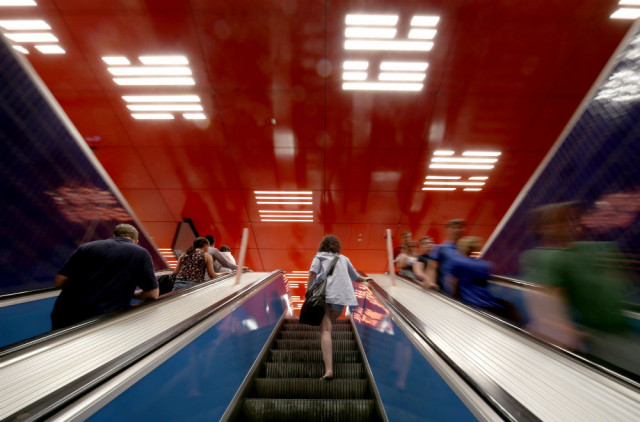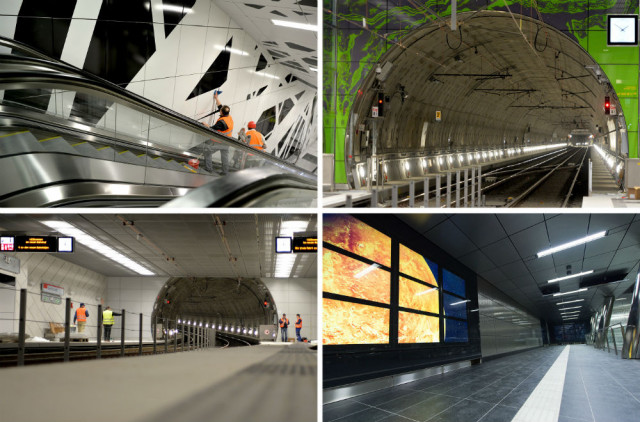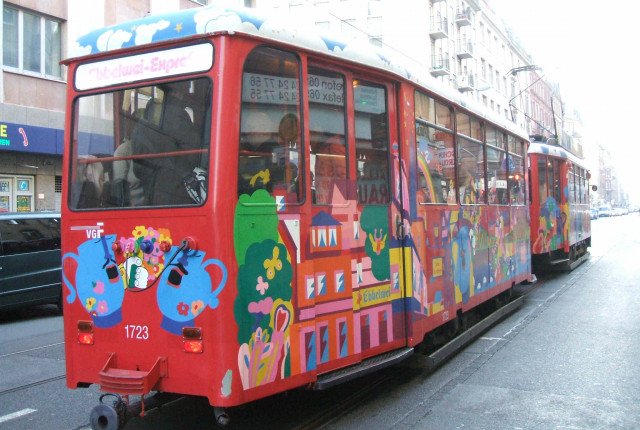How riding Germany's local transport really helps you get under a city's skin

What does it take to get to know a city? An understanding of the culture and being able to speak the language? That definitely helps. But The Local’s Rachel Loxton argues gaining knowledge of the public transport system is the key to settling into a new place.
It doesn’t surprise me that Iggy Pop’s 1977 classic The Passenger was inspired by riding the S-Bahn in Berlin. Sometimes we don’t realize it but public transport, whether it’s buses, trams, trains or the underground, can have a huge influence on our lives – especially when we’re in a new city or country.
To most people who move somewhere new, getting around is the first obstacle. It determines where you go, who you meet and what you do. How you do it depends on how much money you have in your pocket. Maybe you buy a Monatskarte (monthly card) or a Deutschlandticket for endless journeys, or ration your cash with the odd day ticket. Perhaps you sometimes travel without a ticket and risk the wrath of the transport controllers ruining your day.
It’s hard to believe now but when I first arrived in Berlin for a three-month fellowship in 2015, I hated using the metro system. In fact, for the first few days I refused to go on any trips alone that involved changing lines. I had a huge fear of getting lost since arriving in a big city with a complex transport system can be daunting.
Luckily I got over that anxiety quickly, otherwise I would have had to walk across the whole of Berlin, which is neither practical nor appealing. I began getting used to the lines, from the unpredictable U8 (I once saw a drunk guy carrying a vacuum cleaner in the middle of the night and there’s also the occasional naked person) to the U2 with its many buskers and tourists.
 Marienplatz U-Bahn station in Munich. Photo: DPA
Marienplatz U-Bahn station in Munich. Photo: DPA
Don’t get me wrong, I love walking and cycling. But studying public transport and its routes is how I get under the skin and properly into a city's bones. I don't mean just to ride to different places but also mentally noting the names down, registering each stop and observing strangers and moments closely. These are the places where social inequalities are exposed, often in the form of homeless people asking for money, or where groups of friends meet. Listening carefully to announcements like ‘Einsteigen bitte’ (please board) helps with the language learning process.
Expat Oliver Matthews, head of marketing at Frankfurt School of Finance and Management, says he can understand why newcomers to Germany can find getting around unsettling. The 39-year-old from Northampton, UK, who has lived in Frankfurt since 2013, says: “To someone new arriving in Frankfurt, it’s a bit tricky understanding the system - and the buses are the most frustrating.”
Matthews, who runs the website Frankfurt Expat, advises navigating with the S-Bahn and U-Bahn lines first before moving on to the tram network and buses, or do what he did – go to a tourist information office.
“I asked them to explain how everything works,” he says. “They pulled out a map, showed me all the routes and told me how they connected together.”
Favourite lines
The moment I knew I was beginning to understand Berlin was when I picked my favourite bus route: the 248. To anyone who’ll listen I’ll talk about how it hurtles between Südkreuz and Ostbahnhof/Warschauer Straße, past intriguing street names like Adolf-Scheidt-Platz, Bäumerplan, Werner-Voß-Damm, Gneisenaustraße and Hallesches Tor.
It drives south to east, stopping by Fischer Insel (fisher island) just behind the Soviet mish-mash of Alexander Platz, across from the monstrous Alexa shopping centre. It then cuts east to Friedrichshain, a place once known for its squat-culture that's now home to tourists, hipsters and the techno club Berghain. It’s a journey that helps you get to know Berlin.
Canadian expat Jenna Davis, who moved to Düsseldorf from Toronto three and a half years ago, agrees that getting to know the transport system is how you acclimatize yourself in a new place. The 26-year-old, who creates content and works on social media in the tourism industry, says Düsseldorf’s recent U-Bahn upgrade, which took 15 years to complete, means people are “embracing public transport”.
“It’s super exciting because there’s so many more opportunities to get from A to B,” she says.
The renovated underground stations are also home to an ambitious art project which doesn’t allow any adverts.
 Images taken in 2016 of four new underground stations in Düsseldorf. Photo: DPA
Images taken in 2016 of four new underground stations in Düsseldorf. Photo: DPA
Davis says: “It’s a lot more fun now to actually take the public transport because every single one of our U-Bahn stations is a different art piece designed by a different artist. People now explore the stations and gain their bearings that way.”
Davis runs the blog Life In Düsseldorf and often receives queries from expats about the best way to get a driving licence in order to drive in the city.
But she always advises them to get on board with public transport.
“Coming from Canada I know a lot of expats have this mentality where they want to get a car,” she says. “It’s a hard thing for North American expats to grasp but I kind of think once you get passed this barrier of feeling strange with public transport it’s a much better way to explore.”
Düsseldorf is split by the River Rhine - which only adds to the public transport character, according to Davis.
“Our map is a little wild,” she says. “I would say my favourite is the U71 line because it starts in the Flingern area, a more modern district where a lot of expats live. Then it goes to the centre and stops right in the middle of Schadowstraße, which is very cool."
“Then it runs all the way to Benrath where there’s a pink castle.”
While Frankfurt may be well known for its buzzing financial district, Oliver Matthews suggests seeking out different routes to see alternative sides to the city.
He recommends the Ebbelwoi Express.
“It’s the most interesting tram,” he says. “Ebbelwoi is the Frankfurt dialect for apple wine. “That’s basically flat cider. This tram goes around the city connecting the different apple wine bars, from Sachsenhausen up to Nordend."
“It’s decorated really nicely with pictures and it’s good fun.”
 The Ebbelwoi Express. Photo Flick/Shankar S.
The Ebbelwoi Express. Photo Flick/Shankar S.
Iggy was onto something
Another route I'm a fan of in Berlin is the U1, which runs from Warschauer Straße to the Kurfüstendamm area. The east to west route is iconic and I don’t use that word lightly. It flies overground from the buzz of the east, stopping at Prinzenstraße, arguably a complete mess of a station with a 1980s-style pink and green design.
The U1 is also home to Kottbusser Tor, nicknamed Kotti, an area that’s as chaotic as Alexanderplatz but with more characters. Then there’s Möckernbrucke and rainbow-covered Nollendorf Platz, where it swoops down underground. It carries on to Wittenberg Platz, one of the oldest stations in Berlin, with an Art Nouveau feel to it. Kaufhaus Des Westens (KaDeWe), where German actor Marlene Dietrich bought her undergarments, is just outside it. It ends at Uhlandstraße, the glitzy side of town.
It's interesting to see the impact the Berlin Wall has had on the public transport system. Each side has grown its own network and today they're like pieces of a jigsaw puzzle that don't quite fit together.
There are so many other towns and cities across Germany that I’ve yet to explore. On a recent trip to Leipzig I was fascinated by some of the old-style trams that featured a bell ringing at every stop.
Meanwhile, my friend Danny, a Scottish expat in Germany, says Munich’s metro system, one of the most efficient in Europe, felt “sprawling” but “functional” and was the perfect way to get to know the Bavarian capital.
Maybe you’re not destined to write a song inspired by hopping on and off trains like Iggy, but every journey you take is shaping your experience of a city. And that’s why being The Passenger is anything but boring.
This article was first published in 2018.
Comments
See Also
It doesn’t surprise me that Iggy Pop’s 1977 classic The Passenger was inspired by riding the S-Bahn in Berlin. Sometimes we don’t realize it but public transport, whether it’s buses, trams, trains or the underground, can have a huge influence on our lives – especially when we’re in a new city or country.
To most people who move somewhere new, getting around is the first obstacle. It determines where you go, who you meet and what you do. How you do it depends on how much money you have in your pocket. Maybe you buy a Monatskarte (monthly card) or a Deutschlandticket for endless journeys, or ration your cash with the odd day ticket. Perhaps you sometimes travel without a ticket and risk the wrath of the transport controllers ruining your day.
It’s hard to believe now but when I first arrived in Berlin for a three-month fellowship in 2015, I hated using the metro system. In fact, for the first few days I refused to go on any trips alone that involved changing lines. I had a huge fear of getting lost since arriving in a big city with a complex transport system can be daunting.
Luckily I got over that anxiety quickly, otherwise I would have had to walk across the whole of Berlin, which is neither practical nor appealing. I began getting used to the lines, from the unpredictable U8 (I once saw a drunk guy carrying a vacuum cleaner in the middle of the night and there’s also the occasional naked person) to the U2 with its many buskers and tourists.
 Marienplatz U-Bahn station in Munich. Photo: DPA
Marienplatz U-Bahn station in Munich. Photo: DPA
Don’t get me wrong, I love walking and cycling. But studying public transport and its routes is how I get under the skin and properly into a city's bones. I don't mean just to ride to different places but also mentally noting the names down, registering each stop and observing strangers and moments closely. These are the places where social inequalities are exposed, often in the form of homeless people asking for money, or where groups of friends meet. Listening carefully to announcements like ‘Einsteigen bitte’ (please board) helps with the language learning process.
Expat Oliver Matthews, head of marketing at Frankfurt School of Finance and Management, says he can understand why newcomers to Germany can find getting around unsettling. The 39-year-old from Northampton, UK, who has lived in Frankfurt since 2013, says: “To someone new arriving in Frankfurt, it’s a bit tricky understanding the system - and the buses are the most frustrating.”
Matthews, who runs the website Frankfurt Expat, advises navigating with the S-Bahn and U-Bahn lines first before moving on to the tram network and buses, or do what he did – go to a tourist information office.
“I asked them to explain how everything works,” he says. “They pulled out a map, showed me all the routes and told me how they connected together.”
Favourite lines
The moment I knew I was beginning to understand Berlin was when I picked my favourite bus route: the 248. To anyone who’ll listen I’ll talk about how it hurtles between Südkreuz and Ostbahnhof/Warschauer Straße, past intriguing street names like Adolf-Scheidt-Platz, Bäumerplan, Werner-Voß-Damm, Gneisenaustraße and Hallesches Tor.
It drives south to east, stopping by Fischer Insel (fisher island) just behind the Soviet mish-mash of Alexander Platz, across from the monstrous Alexa shopping centre. It then cuts east to Friedrichshain, a place once known for its squat-culture that's now home to tourists, hipsters and the techno club Berghain. It’s a journey that helps you get to know Berlin.
Canadian expat Jenna Davis, who moved to Düsseldorf from Toronto three and a half years ago, agrees that getting to know the transport system is how you acclimatize yourself in a new place. The 26-year-old, who creates content and works on social media in the tourism industry, says Düsseldorf’s recent U-Bahn upgrade, which took 15 years to complete, means people are “embracing public transport”.
“It’s super exciting because there’s so many more opportunities to get from A to B,” she says.
The renovated underground stations are also home to an ambitious art project which doesn’t allow any adverts.
 Images taken in 2016 of four new underground stations in Düsseldorf. Photo: DPA
Images taken in 2016 of four new underground stations in Düsseldorf. Photo: DPA
Davis says: “It’s a lot more fun now to actually take the public transport because every single one of our U-Bahn stations is a different art piece designed by a different artist. People now explore the stations and gain their bearings that way.”
Davis runs the blog Life In Düsseldorf and often receives queries from expats about the best way to get a driving licence in order to drive in the city.
But she always advises them to get on board with public transport.
“Coming from Canada I know a lot of expats have this mentality where they want to get a car,” she says. “It’s a hard thing for North American expats to grasp but I kind of think once you get passed this barrier of feeling strange with public transport it’s a much better way to explore.”
Düsseldorf is split by the River Rhine - which only adds to the public transport character, according to Davis.
“Our map is a little wild,” she says. “I would say my favourite is the U71 line because it starts in the Flingern area, a more modern district where a lot of expats live. Then it goes to the centre and stops right in the middle of Schadowstraße, which is very cool."
“Then it runs all the way to Benrath where there’s a pink castle.”
While Frankfurt may be well known for its buzzing financial district, Oliver Matthews suggests seeking out different routes to see alternative sides to the city.
He recommends the Ebbelwoi Express.
“It’s the most interesting tram,” he says. “Ebbelwoi is the Frankfurt dialect for apple wine. “That’s basically flat cider. This tram goes around the city connecting the different apple wine bars, from Sachsenhausen up to Nordend."
“It’s decorated really nicely with pictures and it’s good fun.”
 The Ebbelwoi Express. Photo Flick/Shankar S.
The Ebbelwoi Express. Photo Flick/Shankar S.
Iggy was onto something
Another route I'm a fan of in Berlin is the U1, which runs from Warschauer Straße to the Kurfüstendamm area. The east to west route is iconic and I don’t use that word lightly. It flies overground from the buzz of the east, stopping at Prinzenstraße, arguably a complete mess of a station with a 1980s-style pink and green design.
The U1 is also home to Kottbusser Tor, nicknamed Kotti, an area that’s as chaotic as Alexanderplatz but with more characters. Then there’s Möckernbrucke and rainbow-covered Nollendorf Platz, where it swoops down underground. It carries on to Wittenberg Platz, one of the oldest stations in Berlin, with an Art Nouveau feel to it. Kaufhaus Des Westens (KaDeWe), where German actor Marlene Dietrich bought her undergarments, is just outside it. It ends at Uhlandstraße, the glitzy side of town.
It's interesting to see the impact the Berlin Wall has had on the public transport system. Each side has grown its own network and today they're like pieces of a jigsaw puzzle that don't quite fit together.
There are so many other towns and cities across Germany that I’ve yet to explore. On a recent trip to Leipzig I was fascinated by some of the old-style trams that featured a bell ringing at every stop.
Meanwhile, my friend Danny, a Scottish expat in Germany, says Munich’s metro system, one of the most efficient in Europe, felt “sprawling” but “functional” and was the perfect way to get to know the Bavarian capital.
Maybe you’re not destined to write a song inspired by hopping on and off trains like Iggy, but every journey you take is shaping your experience of a city. And that’s why being The Passenger is anything but boring.
This article was first published in 2018.
Join the conversation in our comments section below. Share your own views and experience and if you have a question or suggestion for our journalists then email us at [email protected].
Please keep comments civil, constructive and on topic – and make sure to read our terms of use before getting involved.
Please log in here to leave a comment.